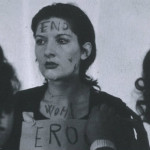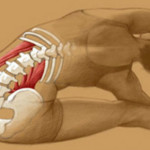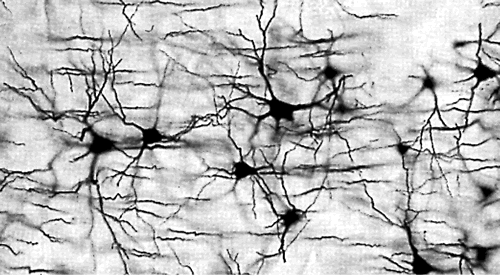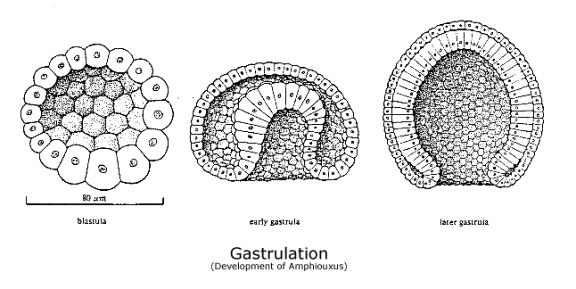
“I am not (what you need from) my body”: expanding on a yoga meme
February 5, 2014
Update #2: What Are We Actually Doing in Asana? \\\ Questions, questions, questions!
February 15, 2014Précis: The means by which we can feel and imagine what we call the “soul” — the nervous system — forms by materially folding inward during embryonic development. Later, the “soul” forms by the inward-folding of introspection.
__________
In most spiritual speculations into the origin of a human life, a subtle essence of disembodied will is theorized to “descend” or “enter” into material incarnation to act out a role or to learn a lesson. The inner ethereal being is thought to both precede, create, and survive the sheathe of flesh, which St. Paul describes as a “tent” in 2 Corinthians 5, Krishna describes as “clothing” in 2.22 of the Bhagavad Gita, and Plato describes as a prison-house assigned by karmic lottery in the last book of the Republic. The same theme of subtle-creating-gross is repeated more delicately in the naturalistic thought of ancient medicine, which holds that the vitalizing breath (prana in Sanskrit, qi in Chinese, ruach in Hebrew, pneuma in Greek) begins to stir and organize matter around itself at the provocation of the soul or a divine force. “You created my inmost being,” sings David in Psalm 139:13. “You knit me together in my mother’s womb.” Invisible intelligence has long been felt to form the inner core of human life, and design its presence. A primal desire to live is felt to condense invisible energies into tissues that can move and express that desire. The invisible is said to give birth to the visible; the immaterial is said to give birth to the material.
Contemporary mystics retain and extend these ideas as doctrine, even in the shadow of evolutionary theory, which holds both intelligence and intention to be products of natural selection and biological complexity. Sri Aurobindo, referencing the Tantric idea of “divine play”, describes the “involuting” descent of spirit into matter as the necessary stimulus for matter to evolve back into spirit. (The Life Divine) Most other forms of yogic wisdom hold that subtle energies of consciousness and intention precede the grosser appearances of matter, in the same way that an architectural blueprint will precede a building. Teilhard de Chardin, alluding to the narrative of Jesus, declares “We are not human beings having a spiritual experience, but spiritual beings having a human experience.” (Phenomenon of Man)
These and countless other sentiments intimate the epic narrative of the soul’s long journey into a place where it must build or acquire the material raft — the flesh — to return to its non-material home. According to this widely-held view, the insoluble quandary of life, and therefore the target of spiritual learning, is the invisibility of the blueprint, the motivation. There is a stimulus for and purpose to our lives that is hidden from our senses, and therefore from science. But if we commit ourselves to devoted contemplation of the super-mundane, we might perceive it directly. If we meditate, we may contact, dialogue with, and even fall into communion with this hidden source of us, which, strangely, preceded all of the faculties by which we seek it out.
If we sidestep the religious commitments held by such traditions, and set aside the question of how their proponents might produce evidence for the a priori nature of consciousness, might we see that they’re simply describing how life simply feels? Don’t our journeys through this world feel at times like journeys into this world? Don’t we seem to “enter” a fully formed and given world from the womb, as though from another dimension? Does it not feel on a moment by moment basis like our “inmost beings” are at the beginnings of things? Do we not feel that immaterial intentions — from dark impulses to conscious thoughts — catalyze material actions? To what extent do we hang our belief in free will upon precisely this: that we feel something most intimately inside us, something more than these hands or these eyes, something like the origin of desire and decision — something like a self, always already there — commanding the movement of the flesh and perhaps its very existence? Is it really a stretch to extend this sensation into a story of spirit preceding matter, and vitalizing its movements?
With all of these feelings — internal intention being felt as initiatory to action, and spiritual alienations, harmonies, and ecstasies usually described according to their internal sensations — we can understand why many ancient systems propose a “subtle” or “energetic” body within the flesh, which is proposed as a conduit of the inmost being or soul. This ghostly controller-body is an abstraction of the flesh — elegantly compact, symmetrical, florid with symbols — that both holds the soul, and provides a pathway for its eventual transcendence from the flesh. When imagined as channels and cakras, the subtle body provides focal points for the interpretation of emotions and their visceral locations. The layers of the perineum, the hollow of the pelvic bowl, the “navel centre”, the solar plexus and the others become sites of tension if the soul is stuck, sites of freedom if it is flowing.
Given this concentration upon felt states, it’s not surprising that at some point in the early 20th century, occultists both East and West began associating this subtle body with the actions of the “grosser” central nervous system, focusing upon the apparent symmetries between the cakras and the gatherings of nerve plexes along the spinal cord. Suddenly, the lotuses and bija-mantras that constituted the visual metaphors for the soul’s home seemed to merge with the floral and root-like structures of the visible nerves now hauntingly exposed by Camilo Golgi’s method of staining with potassium dichromate and silver nitrate.

neurons revealed by the Golgi method
In the discourse of modern postural yoga, the nervous system has become the biomedical vehicle for the cakras and channels (Alter, 2004), just as the cakras and channels are themselves the chimerical playground of the soul. When contracted through sympathetic function, the nerves are imagined or felt to squeeze the subtle body, to entrap the inmost being. When dilated through parasympathetic function, the nerves unbind the channels, and the soul is imagined or felt to be settled, at home, or “in yoga”. Thus the layperson’s understanding of the nervous system has now given the soul a place where it can be specifically felt, contacted, and perhaps eventually seen through neuroimaging.
It’s important to note that this merging of the energy body with the nervous system is not entirely a modern innovation: in Ayurveda, it is said that majjā dhātu (often translated as “nervous tissue”) is governed by the psychosomatic principle of vāta, which is itself a conspiracy of air and space elements, which in turn are the media of breath and consciousness. That the physical nervous system relates to the felt sense of the soul is not a new idea. “The core of majjā dhātu is to create the feeling of ‘I am’”. (Lad, 2002, 159)
But what does our current knowledge of the nervous system itself tell us about the origin of this felt, inmost being? If the soul is a priori to the growth of the flesh, wouldn’t this suggest that the nervous system arises first in our embryology, and governs future growth? But it doesn’t. In fact, the development of the central nervous system proceeds along an arc that seems quite opposite to the spiritual birth-narrative. This most subtle of our faculties is not the catalyst of our growth, as the soul would be to flesh. It is not there at the beginning. It doesn’t express an agency of creation or self-expression. Most strangely — it doesn’t even form from within the embryo, but through a process of invagination from the embryo’s surface layer. If the analogy of subtle body to nervous system considers the story of their origins, we might say – contradicting the spiritual narrative – that the subtle body is created by the flesh, subsequent to it.
A brief outline of two embryonic phases — gastrulation and neurulation — will help. Gastrulation is the process by which the early cell-clump of an embryo (blastula) begins to differentiate into a three-layered structure (gastrula), from which the variant properties of tissue-groups emerge. The innermost layer — the endoderm — will go on to form the epithelial tissues of the organs and involuntary musculature. The middle layer — the mesoderm — goes on to form structural tissues like muscle and bone, along with the circulatory systems that feed them. The topmost layer — the ectoderm — gives rise to the skin, but also, and crucially, a certain patch of complex and sensitive epidermal cells that thicken to form a structure called the neural plate, which develops a hinge along its centre line.

Neurulation follows. The cells of the neural plate are formed from a stretch of the expanding epidermal cell mass that stops growing, perhaps, one may imagine, to turn its attention to feeling. As the bulk of the surrounding epidermis increases, it applies pressure to the neural plate and its central hinge, which, at some exquisite moment at around the twentieth day after conception, begins to buckle and fold inward in a process called “invagination”. As the hinge moves inwards, the lateral edges of the neural plate are pushed towards each other above the indentation. Between days twenty-five and twenty-seven these edges meet and fuse with each other, forming the upper enclosure of what is now a neural tube within the gastrula, a tube which will form the main conduit for the spinal cord.
When this tube fails to fuse at the end of the elongating embryo that will become the sacrum, the baby will be born with a variation of spina bifida, in which a part of the spinal cord is exposed through an opening in the spine. When the tube fails to fuse at the cranium, the baby will be born with a brain stem but without a cortex, with a flattened or even open skull, and will experience little to no sensory perception, will never achieve conscious life, and will typically die within hours or days, if it is not stillborn. Anencephaly can now be detected through ultrasound from the eleventh week of pregnancy, and when it is discovered the vast majority of parents choose to terminate the pregnancy, knowing the fetus will never attain the core capacities of personhood. The near-universality of this choice would seem to speak to a broad cultural understanding that the nervous system contains or even constitutes the basis for the inmost being, and which, in the anencephalic baby, is simply absent.
Through this process of neural tube invagination, and contrary to the impressions that form the common spiritual birth-narrative of subtle-begets-gross, we can see that the root of our very capacity to feel our interiority, to sense whatever inmost being we feel to be there — does not originate from a space within, or from some interior catalyzing energy. Rather, it grows into us from an outer surface and through exterior contact. The surface through which we will go on to contact the world most directly becomes the internal holder of experience. The nervous system begins as an externality, and becomes the basis for our internality. Accordingly, I propose that our inmost sensations, and the notions of the soul these sensations turn into, follow the same outside-to-inside developmental arc. The internal spaces we come to identify as our inmost being grow into us through an infolding of the surfaces through which we meet the world.

neurulation
The implications for yoga, mindfulness, and meditation techniques could be profound. Is it possible that, rather than using practice to seek within for an original source, primal cause, essential Self, or even a non-specific “Buddha nature”, we might be literally creating such sensations and notions within previously unsensed spaces, in the same way that neurulation folds inward to form the primal spinal cord? If so, spiritual practice might shift from a process of trying to remember a lost unitive state by recovering from Aurobindo’s “involution”, or by remembering de Chardin’s “spiritual being”. It might be seen as a process of feeling our way into a variety of internal integrations. The teleology of spiritual evolution from “fallen” to “risen”, with its meditative benchmarks and rankings of saints, might be deconstructed into a paradigm of exploration and innovation.
Most importantly, the process might be understood as radically interdependent. The internalizing movement of neurulation, after all, occurs in the context of constant hormonal communication with the uterine lining. At its root, the nervous system evolves from outside to inside through the intimacy of relationship. Likewise, a spirituality that conceives of its essence as created relationally, and in the movement from outside to inside, may discover that “self” really does derive from “other.”
From the primal formation of the neural tube, the process of invagination is repeated logarithmically throughout gestation. In the gastrula, further cellular differentiation encourages the endoderm to fold inwards at multiple creases to form the tubes and sacs of the organs. The mesoderm folds inward, mainly around the endoderm pockets, to form a containment architecture that will harden into bone, muscle, and sinew. As the cerebral cortex grows within its limited space, it invaginates continually to produce more surface area to enable more neuronal relationship. Internal folds allow our neurology to meet itself more closely and communicate more richly. This folding produces the well-known walnut-like surface of bulges and furrows.
Invagination continues into psychic and linguistic realms of early childhood development. The first back-arching reflexes of individuation come as startle-responses to external confinements or internal discomforts. Later, through the loosely-defined “mirror stage”, the child encounters and recognizes an image of itself, and then internalizes this notion of a self-image that others may view, along with the disarming feeling of remaining distinct from that image. Gradually, introspection emerges, beginning with the crystallization of being a person separate from the mother, a person in a world, feeling the world as outside, but also the eerie pull of the silence within. Introspection is invagination of the subtlest order: an inward folding that creates distinct streams of internal vibrancy that will dialogue with each other.
Language deepens this groove by hardening the categories of subject and object, and allowing the self-referentiality of thinking to become measured and explicit. As soon as certain statements can be made — “I’m three”, or “I’m hungry”, or “I’m jumping”, or “I’m sad”, or “I have a soul” — the child is well on its way to metacognition, an infolding of mental life focused on the very condition of being something that feels and thinks. Added complexity comes as language becomes self-reflexive: “I am using a lot of big words now, Mummy.” The distance between the “I” who is watching and the “I” who is “jumping” comes at the end of a series of internal folds: neurulation to form the brain, the brain to form itself, perception to encounter itself, and language to describe itself. Before all of these things happen, we are a series of surfaces, rubbing up like the blastocytes we once were against externalities that define our boundaries and score us with their edges, creating lines along which we fold inwards.
As in the gastrula and the pre-conscious baby, there is little within us before we actually turn inwards and make an inside-for-ourselves, begin to explore our raw autonomic potential, and to fill up our inner spaces. That old Ayurvedic term for nervous tissue — majjā — comes from the root maj, which means “to sink down into”. Oral tradition adds that the purpose of majjā dhātu is to “fill the empty spaces of the body with bliss.”
What do we find when we consciously turn inwards, following the invaginating pathways of our neurology? Sensations of breath, digestion, circulation. The echoes of other voices, and our own voice made other by its echoes and premonitions. Pockets of silence and light. We remember things distinctly. Or we blend memories. Or we braid memory with desire into fantasy. When we begin to look, we find all of the things that have folded into us over time, along with the distances between those folds that create the internal senses of time and multiple selves.
What then is the soul? If it rides on the nerves, it is something far less than an eternal and originating essence, but also much more than a conspiracy of theologians. Something not found by introspection, but made by it. And made not only over the long-term hardening of the concept, “soul”, built upon countless reflections upon internal sensations, but also made in each individual moment of introspection itself. For where is the soul when we are not thinking of it? If it exists beyond our conceptualization, introspection will never find it. William James: “Introspective analysis… is… like seizing a spinning top to catch its motion, or trying to turn up the gas quickly enough to see how the darkness looks.” (1892, vol. 1, 244)
What have we made within ourselves, and what are we searching for amongst these folds that harden into inner architectures of desire? Is the soul a process of deciding where one is at home? Is the soul the internal image we’ve created of the love-object that made us: the world? Is the soul the internal mother, the constancy (Kaplan, 1978) we made on our journey to individuation? The place where we would say I am here for now, I am at rest for now, I am nurtured for now. And though I will move onwards I am glad for this moment. The soul is these things surely, and perhaps as many other things as there are people to create it. Sri Aurobindo and Teilhard de Chardin may have it exactly wrong. We may be human beings having spiritual dreams. Those dreams can be about anything at all.
References:
Alter, Joseph S.. Yoga in modern India: the body between science and philosophy. Princeton, N.J.: Princeton University Press, 2004. Print.
Chardin, Pierre. The phenomenon of man. New York: Harper, 1959. Print.
Ghose, Aurobindo. The life divine. New York: Greystone Press, 1949. Print.
James, William. Psychology. New York: Henry Holt and Co., 1890. Print.
Kaplan, Louise J.. Oneness and separateness: from infant to individual. New York: Simon and Schuster, 1978. Print.
Lad, Vasant. Textbook of Ayurveda. Albuquerque, N.M.: Ayurvedic Press, 2002. Print.